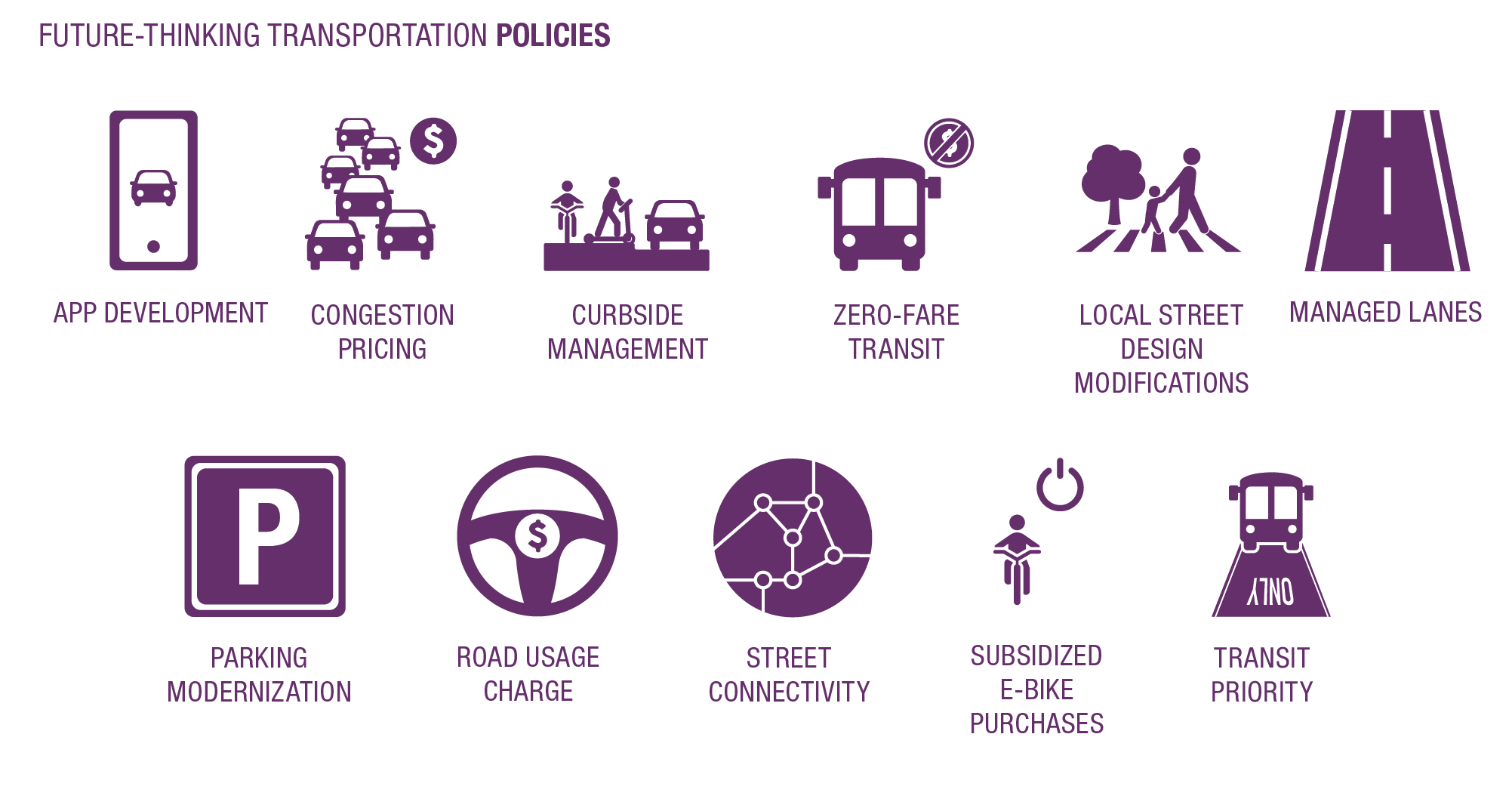
To respond to the uncertainty created by the external forces identified in the RTP, WFRC identified 11 policies informed by research and literature reviews. Similar to the external forces, these policies were reviewed and discussed by the four peer groups and further refined. Each policy was further explored through technical support, additional studies, conversations, or included within the RTP document as a written portion. Each policy aims to address future uncertainty and better equip the Region to become more resilient to change. Below is a description of each policy including how it will be explored and its potential impact on the Region.
A tech service on smart phones that allows users to plot out, order, share, and pay for a wide variety of transit/transportation options.
Use of transportation apps has the potential to reduce travel time, cost, and vehicle emissions. Transportation apps impact travel by providing options to people, letting them know the most efficient route. Not everyone has access to a smart phone with these application technologies which raises equity concerns.
Tolling to enter a cordoned area within a city. Does not include traditional toll lanes and roads.
Congestion pricing has the potential to reduce peak-hour travel time by as much as 25% and can also increase transit ridership and reduce emissions. However, it also raises equity concerns which should be mitigated.
The rise of transportation network companies, micro-mobility devices and stations, and personal delivery services are joining existing demand for space by pedestrians, drivers, bicycle infrastructure, transit service, etc.
Better curb management has the potential to reduce illegal parking that increases congestion and delay, as well as the potential to increase transit reliability and accessibility. Curb management policies require a high degree of coordination between city departments, transit agencies, and private mobility companies, as well as adjacent land uses.
Policies such as design and speed modifications, traffic calming measures, road diets, and right-sizing streets all aim to match land use context with traffic demand.
These design modifications can improve the suitability and safety of roads for all modes of travel, especially as new technologies such as connected and autonomous vehicles and micro-mobility continue to evolve.
Managed lanes are operational strategies that optimize the carrying capacity of existing transportation facilities. Some strategies include: high-occupancy vehicle (HOV) lanes, toll roads, reversible lanes, and ramp metering.
Managed lanes can increase mainline throughput, network productivity, and overall travel time reliability depending on which strategy is applied.
Modernization of parking systems, including elimination of parking minimums, adoption of paid parking, and unbundled parking costs.
Parking modernization policies may lead to more efficient land use, reduced vehicle use, and less roadway congestion. However these benefits come at the expense of lost parking revenues and successful parking modernization programs will likely require significant technological investments
A road usage charge is a usage-based fee based on a certain rate per mile traveled, replacing or supplementing taxes imposed on fuel consumption.
Road usage charge programs more effectively match user impacts to the fees users pay when compared to fuel taxes. This could lead to a decrease in overall vehicle miles of travel.
Street connectivity policies aim to provide multiple routes and connections serving the same origins and destinations. These policies can take the form of block length requirements, connectivity indexes, or minimum intersection requirements.
Improving street connectivity reduces VMT, travel delays, and average trip lengths and may also improve walkability. However adding more miles of street can be costly especially when trying to retrofit existing street networks.
Subsidized or discounted purchase programs and trial use programs aimed at accelerating the adoption of electric assisted bicycles for transportation use.
Reducing barriers to trialing and purchasing e-bikes can increase their adoption rates. E-bikes can offer a cheaper transportation alternative to the car, increase physical fitness levels, improve air quality, and decrease noise in cities. However, even with subsidies, e-bikes might still be cost-prohibitive to low SES individuals.
Transit priority policies support creating transportation systems where transit is the priority and it is fast and frequent. Policies utilize lower tech improvements including queue jumping, dedicated lanes, bus only lanes, and intersection improvements. Transit priority should be assisted with high-tech transit systems including transit signal priority, autonomous shuttles, contactless payments, travel advisory systems, and other forms of emerging and transforming technologies.
Prioritizing transit using both low and high tech improvements has the potential to decrease travel times, and improve the reliability and desirability of transit options. These benefits may increase transit ridership in the Region.
Zero-free transit is a policy decision to remove the barrier of paying for transit services. This may be done system-wide or within designated zones.
A majority of fare-free transit systems found an increase in ridership which in turn eased traffic congestion, reduced air pollution, and in some cases, revitalized downtown areas. However, these benefits may come at the expense of crowded buses and loss of fare revenue.
More information about each external force and forward-thinking policy can be found in a Guidebook presented for the peer group discussions.
For additional information regarding the RTP, please contact Jory Johner.

